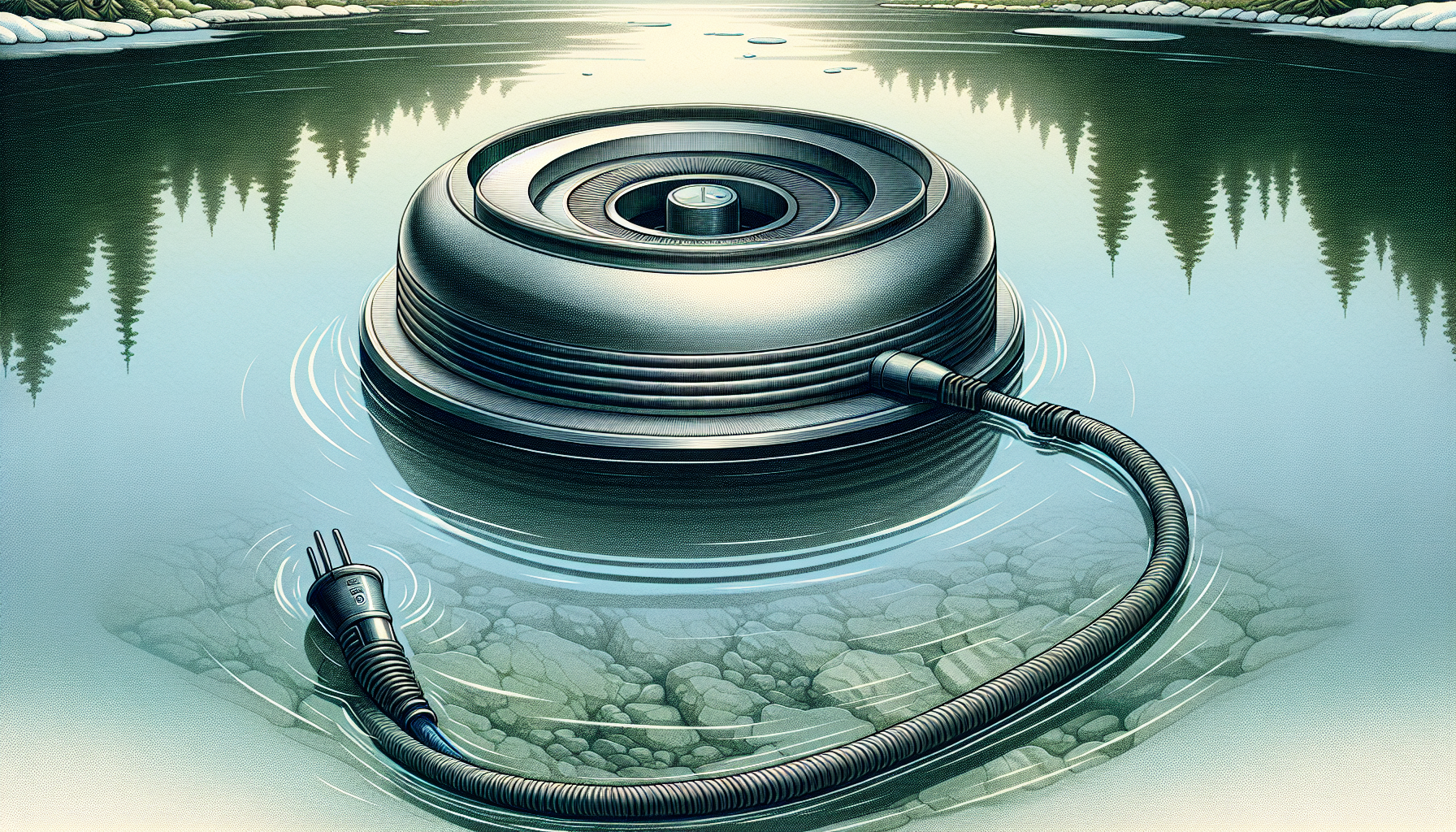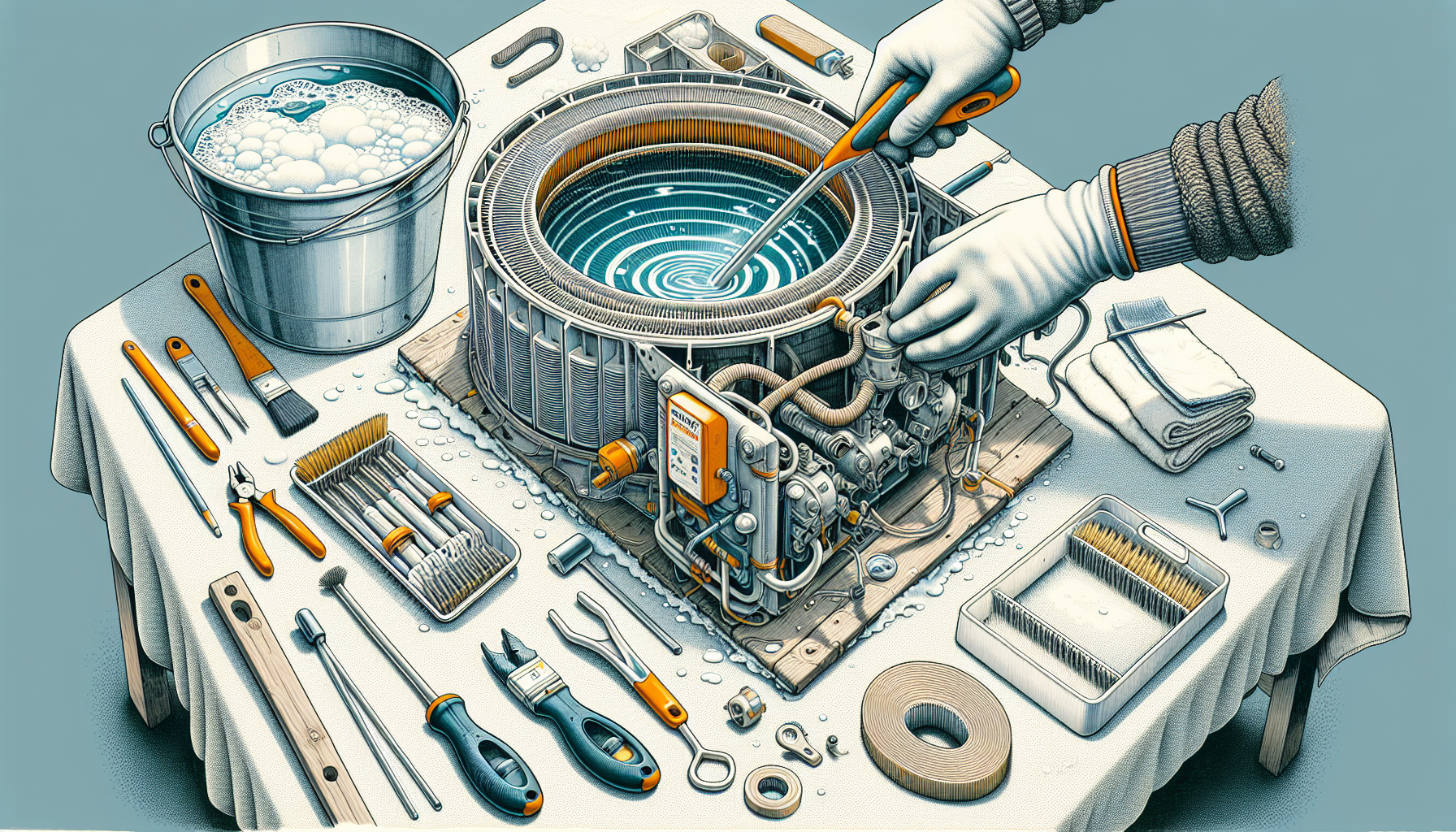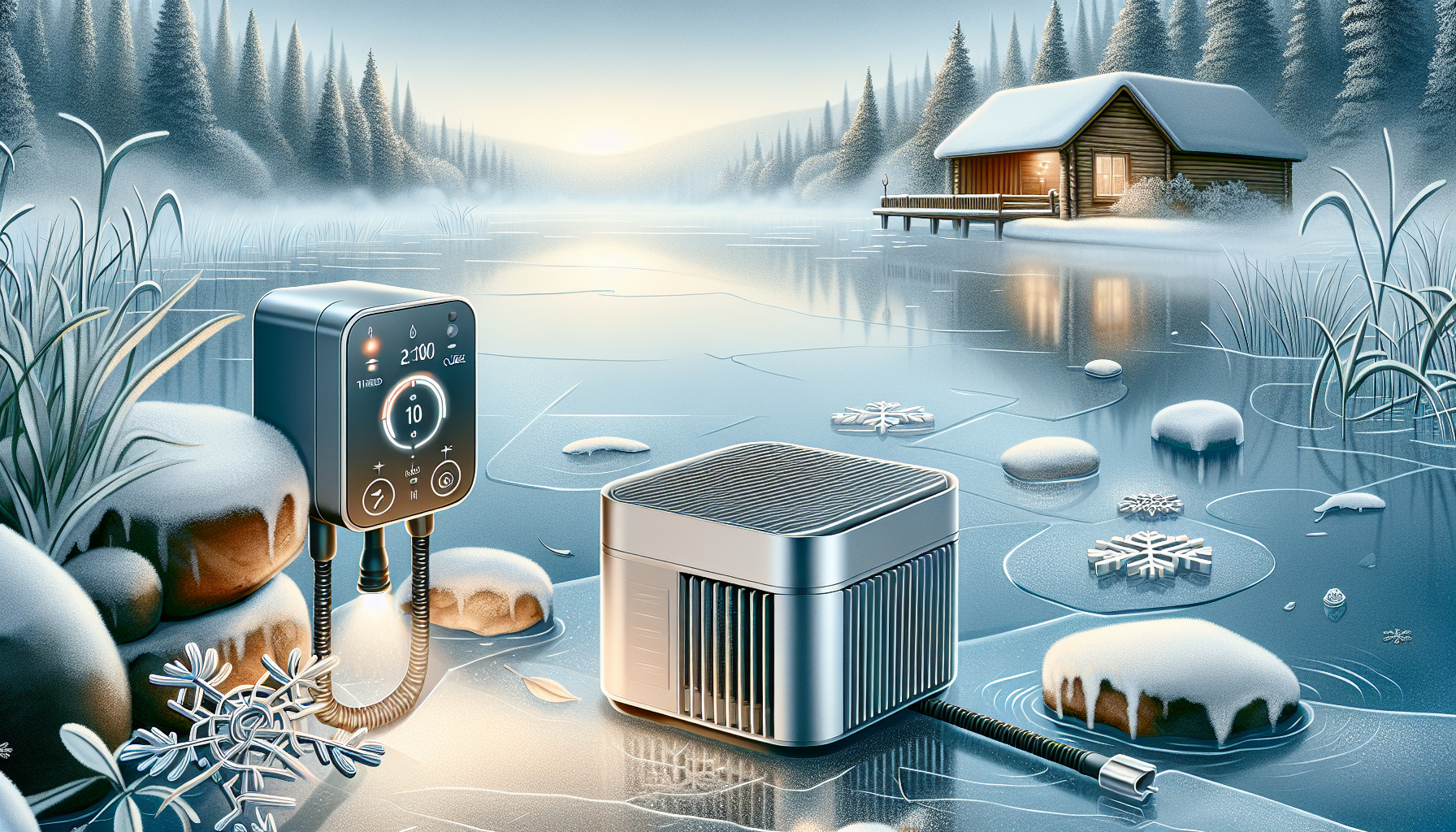Freezing temperatures can be fatal for your pond life if the water surface becomes completely sealed by ice. A pond de icer is your best line of defense, ensuring that essential gases are exchanged and your pond inhabitants survive the winter. It is crucial to use a pond de-icer that will not harm the pond liner, as this ensures a safe and energy-efficient environment for your fish during winter. In this article, we’ll dive straight into how to choose the correct pond de icer for your specific needs, install it properly, and maintain it to function optimally throughout the cold months.
Key Takeaways
-
Pond de-icers are essential for maintaining an opening in the ice to allow toxic gases to escape and oxygen to enter, ensuring the health of aquatic life during winter.
-
Choosing the correct de-icer depends on factors like pond size, depth, fish population, local climate, and wind exposure, and can require assessing between floating and submersible models.
-
Proper installation and maintenance, combined with safe operation practices and optional use of energy-efficient models, contribute to effective de-icing and the overall health of the pond ecosystem during harsh winters.
Understanding Pond De Icers
Imagine a device, floating on your pond’s surface, silently battling the encroaching ice. That’s your pond de-icer, a device specifically engineered to keep a small opening in the ice without harming the pond liner. But how does it work? The de-icer operates by heating up just enough to melt the surrounding ice, crafting a hole without significantly raising the pond’s overall temperature.
But why is this important? The primary purpose of pond de-icers is not to create a winter swimming spot for your goldfish, but to prevent the buildup of toxic gases. They ensure these gases can escape through the opening maintained in the ice, thus creating a safer environment for your pond’s inhabitants.
The Importance of Proper Gas Exchange
The question then arises, why is letting these gases escape crucial? During winter, when your pond is ice-covered, it cuts off the oxygen supply through the surface. Species like fish, frogs, and turtles rely on this oxygen to survive as they breathe through their skin in hibernation. Maintaining an open hole on the pond’s surface is key to letting toxic gases escape and oxygen enter, ensuring a healthy environment for aquatic life.
Now, you might think that one hole open would suffice. However, in ponds with substantial plant material or high pond fish populations, toxic gas buildup and harmful gases can accumulate more rapidly. This might necessitate more than one small hole in the ice.
Even when dealing with a clean pond with low levels of decay and fewer fish, maintaining a proper gas exchange remains critical for the survival of your aquatic buddies, ensuring they stay fish happy.
Selecting the Appropriate De Icer for Your Pond
Choosing the right de-icer for your pond involves considering several factors:
-
The size of the pond
-
The depth of the pond
-
The local climate conditions
-
The wind exposure
It’s important to take these factors into account to ensure that you choose the most effective de-icer for your pond. Additionally, make sure to select a de-icer that will not harm the pond liner to create a safe and energy-efficient environment for your fish during winter.
Assessing Pond Size and Fish Population
When it comes to pond size, the bigger the pond, the more powerful the de-icer must be to maintain an opening in the ice. Additionally, the number of fish in the pond affects the level of aeration needed, which in turn affects the choice of de-icer.
Don’t forget to consider the depth of your pond too. For maximum de-icer efficiency, the device should be placed in a shallow section of the pond, close to the edge. This allows heat reflection off the edges.
Comparing Types: Floating vs. Submersible
Once you’ve assessed your pond’s size and fish population, you need to consider the type of de-icer. The two main types are floating and submersible. The Perfect Climate Pond De-Icers are versatile, with a removable float that allows them to be utilized as either floating or submersible.
Floating de-icers are commonly used, resting on the water surface, and are beneficial for ease of maintenance and observation. Floating de-icers are often preferred because they are less likely to harm the pond liner. On the other hand, submersible de-icers are placed on the pond bottom and are usually more powerful, making them suitable for larger ponds or more intense freezing conditions.
Installation Tips for Maximum Efficiency
Correct installation of your de-icer is as important as choosing the suitable one. This can notably impact the device’s efficiency and effectiveness.
It is crucial to install the de-icer in a way that does not harm the pond liner, ensuring a safe and energy-efficient environment for your fish during winter.
Finding the Ideal Location
Selecting an optimal location for your de-icer can notably enhance its efficiency. Shallower sections near the pond’s edge are considered optimal for de-icer placement because they typically offer the best balance of efficiency and water temperature for hibernating fish.
Choosing a location that’s less exposed to hard freezes and strong winds reduces the need for the de-icer to work harder, thus increasing its efficiency and lifespan.
Ultimately, the de-icer should be situated in a place that ensures efficiency while preventing unnecessary warming of water to avoid disrupting the natural hibernation behavior of fish.
Ensuring Safe Operation
Safety is paramount when operating electrical devices near water. Therefore, using a Ground Fault Circuit Interrupter (GFCI) outlet is recommended when installing a pond de-icer. Regularly check the power cord of the de-icer for any signs of wear or damage to prevent any potential hazards.
It is also crucial to ensure that the de-icer does not harm the pond liner during operation, as this can compromise the safety and energy efficiency of the pond environment.
Also, here are some additional safety tips to keep in mind:
-
Avoid using extension cords with pond de-icers
-
Always unplug the de-icer before removing it from the water
-
Exercise caution when walking around the pond during winter as ice can be slippery and unstable.
Maintaining Your Pond De Icer
Just like any other tool, your pond de-icer requires regular maintenance to ensure its longevity and performance. Regular cleaning is necessary to remove debris and lime deposits from the de-icer. This can be done using a soft brush and a non-acidic cleaning solution to maintain optimal heat dispersion.
Moreover, the heating element should be cleaned with water and a limescale remover regularly to prevent buildup and ensure efficient operation. It is also advisable to send the de-icer for professional maintenance every three years for seals and oil replacement.
Remember, when not in use, the de-icer should be stored indoors, upside down, with the prop facing downward to prevent damage.
Combining De Icers with Other Winter Pond Care Practices
Although de-icers play a significant role in maintaining a healthy pond during winter, they are not the only tool you have at your disposal. Using an aeration kit in combination with a de-icer can help maintain a hole at the surface, add oxygen, and circulate water to eliminate toxic gases.
Maintaining clear sections on the ice or using a diffuser type aerator can prevent ‘winter kill’ by ensuring that some oxygen exchange continues and a portion of the pond surface remains ice-free. Some pond owners even utilize a pond de-icer as a backup system for an aerator to ensure that a hole remains open in the ice during extreme cold or aerator failure.
Energy-Efficient Options for Pond De Icing
The efficiency of a pond de-icer involves not just its performance but also its energy consumption. Thermostatically controlled de-icers are designed to conserve electricity by operating only when necessary. For instance, Thermo-Pond units maintain water temperature just above freezing, preventing ice formation without constant operation.
The Thermo-Pond 3.0 Floating Pond De-Icer is one such pond heater, consuming only 100 watts and specifically engineered to keep a 12-inch hole in the ice, allowing proper gas exchange. Using pond heaters with a thermostatically controlled outlet such as the Thermo Cube can also optimize energy usage by activating the pond de-icer based on air temperature.
Troubleshooting Common De Icer Issues
Despite best care and maintenance practices, you might still face issues with your pond de-icer. If the device is not melting ice efficiently, laying it on its side can help it to slowly melt through the ice without forceful intervention. Suppose the pond is completely iced over. In that case, placing a pan of boiling water on the ice until a hole is melted can create an opening for the de-icer to begin functioning.
In cases where a vent hole has closed, pouring boiling water around the de-icer can help to reopen it by melting substantial ice. And if your de-icer struggles to float, encasing it in a styrofoam box can help insulate and concentrate the heat, potentially improving its ability to prevent ice formation.
Summary
In conclusion, maintaining a healthy pond during winter is not as daunting as it may seem. With the right tools, like a well-chosen and properly maintained pond de-icer, you can ensure a safe and thriving environment for your pond’s inhabitants. Remember, the key to successful winter pond care lies in understanding your pond’s unique needs and adapting your approach accordingly.
Frequently Asked Questions
Why is a pond de-icer necessary?
A pond de-icer is necessary to maintain a hole in the ice during winter, allowing toxic gases to escape and oxygen to enter, thus maintaining a healthy environment for aquatic life. This helps to prevent the pond from becoming stagnant and harmful to the wildlife.
How do I choose the right de-icer for my pond?
To choose the right de-icer for your pond, consider factors such as the pond size, fish quantity, depth, and local climate conditions. It is also important to choose a de-icer that will not harm the pond liner, ensuring a safe and energy-efficient environment for your fish during winter. These will help determine the most suitable option for your specific needs.
How should I install and maintain my pond de-icer?
To install and maintain your pond de-icer, place it in a shallow section near the edge of the pond and clean it regularly to remove debris and lime deposits. Ensure that the de-icer is installed and maintained in a way that does not harm the pond liner. Additionally, it’s advisable to send it for professional maintenance every three years.
Can a de-icer alone maintain a healthy pond during winter?
No, a de-icer alone may not be sufficient to maintain a healthy pond during winter. It is beneficial to combine it with other winter pond care practices, such as using an aeration kit to add oxygen and circulate water.
Are there energy-efficient options for pond de-icing?
Yes, thermostatically controlled de-icers and outlets such as the Thermo Cube are energy-efficient options for pond de-icing. They optimize energy usage by activating based on the temperature, conserving electricity.



















